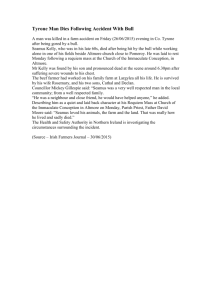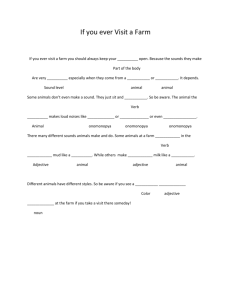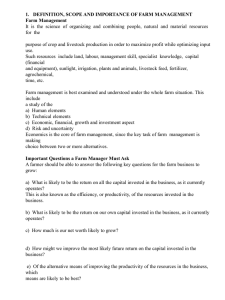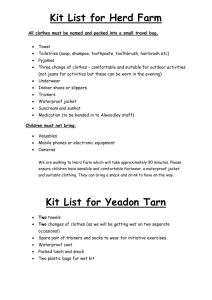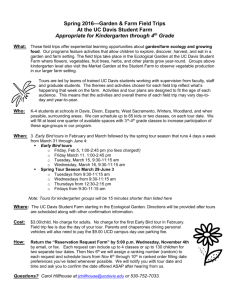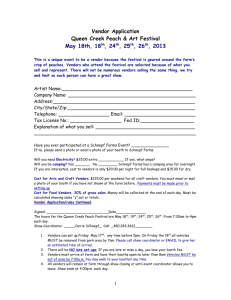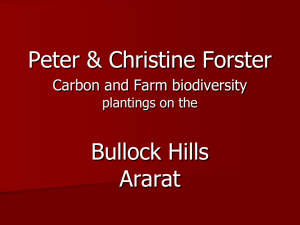English 138, Fall 2011 Erin Kalbarczyk The Farm I don`t get to the
advertisement
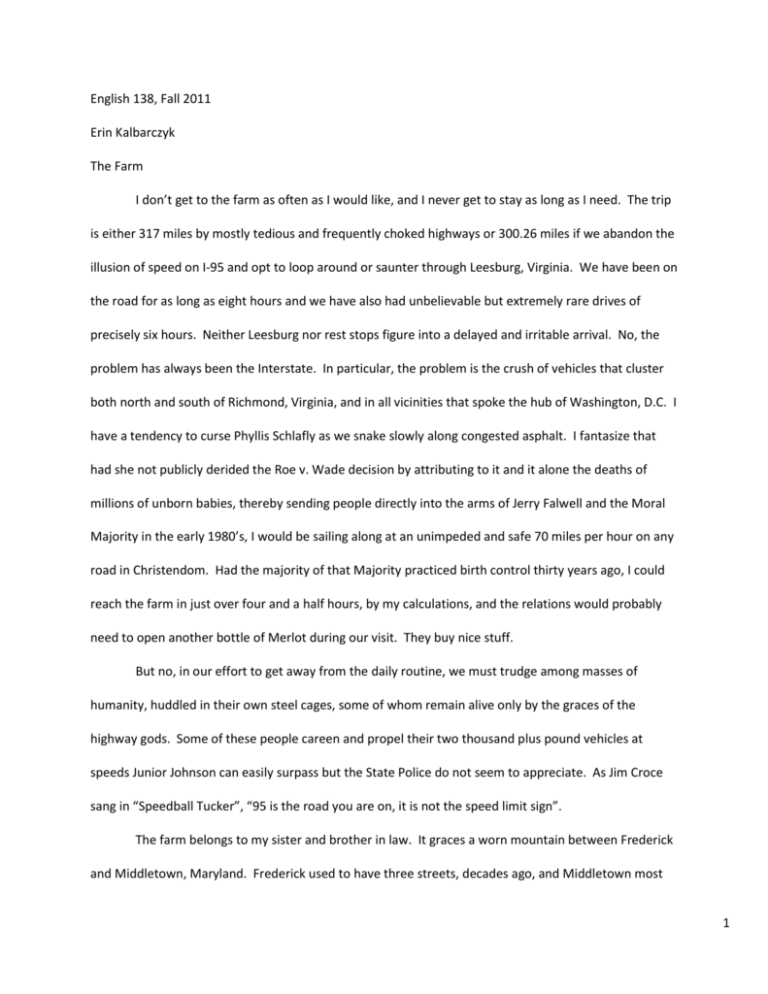
English 138, Fall 2011 Erin Kalbarczyk The Farm I don’t get to the farm as often as I would like, and I never get to stay as long as I need. The trip is either 317 miles by mostly tedious and frequently choked highways or 300.26 miles if we abandon the illusion of speed on I-95 and opt to loop around or saunter through Leesburg, Virginia. We have been on the road for as long as eight hours and we have also had unbelievable but extremely rare drives of precisely six hours. Neither Leesburg nor rest stops figure into a delayed and irritable arrival. No, the problem has always been the Interstate. In particular, the problem is the crush of vehicles that cluster both north and south of Richmond, Virginia, and in all vicinities that spoke the hub of Washington, D.C. I have a tendency to curse Phyllis Schlafly as we snake slowly along congested asphalt. I fantasize that had she not publicly derided the Roe v. Wade decision by attributing to it and it alone the deaths of millions of unborn babies, thereby sending people directly into the arms of Jerry Falwell and the Moral Majority in the early 1980’s, I would be sailing along at an unimpeded and safe 70 miles per hour on any road in Christendom. Had the majority of that Majority practiced birth control thirty years ago, I could reach the farm in just over four and a half hours, by my calculations, and the relations would probably need to open another bottle of Merlot during our visit. They buy nice stuff. But no, in our effort to get away from the daily routine, we must trudge among masses of humanity, huddled in their own steel cages, some of whom remain alive only by the graces of the highway gods. Some of these people careen and propel their two thousand plus pound vehicles at speeds Junior Johnson can easily surpass but the State Police do not seem to appreciate. As Jim Croce sang in “Speedball Tucker”, “95 is the road you are on, it is not the speed limit sign”. The farm belongs to my sister and brother in law. It graces a worn mountain between Frederick and Middletown, Maryland. Frederick used to have three streets, decades ago, and Middletown most 1 likely had only one. Middletown remains village-like, but Frederick is a bedroom community to Washington D.C. that exploded when the I-270 corridor was built and the likes of IBM overtook the land. The house sits at the end of a gravel road, and past the clearing at the back of the house, the land slopes through groves of hardwoods and pines down to the banks of the Catoctin Creek, which empties into the Potomac River. Our sweet and soulful yellow Labrador retriever came with us on past trips, and we almost always walked the path to the creek with him. We could tell the moment he knew the water was within his reach. He would lope along and suddenly his great wide head would tilt and his fine nose would twitch briefly while he came to a standstill, his tail stretched out straight behind him. In a flash he would take off in anticipation of his swim. We always followed. Sam and Sharon’s property line extends to the middle of the creek, which often runs clear enough that we can see its stony bed if there have been no recent rains. The roots of old trees jut out of the earth and into air or water, competing with new seedlings for light and soil nutrients. The mostly steep banks sometimes cede a more gradual path to the water, but that ground is also root bound and rocky. We sidestep down a slope, angling for stable surfaces of brown and grey rock and woody roots to get to the creek. At water’s edge, sometimes we see tadpoles, wriggling to their individual fates. Minnows commune in pools shaded by overhangs. In the summer, we hear crickets squeaking, deep and rhythmic bull frogs, shrill peepers. In the winter, we only hear the water and each other if we speak. When we head back to the house and step out of the woods and into the meadow, we almost always hear a hawk cry, high and sharp as he soars and circles in search of his very own current. He sails skyward, buff-bellied, red-tailed, solitary. We spend a lot of time searching the outdoors even while we are in the house. Banks of windows allow light in all of the rooms on the top floor. From the kitchen we can peer out over the wooden deck to study and discuss the birds lighting and pecking at the feeders: chickadees, finches, the occasional red bellied woodpecker. A hummingbird feeder sees darting in and out activity in the 2 summer. From inside the house, we can watch a hawk soar but cannot hear his call. From the bow window in the living rooms, in the front of the house, we can see the vegetable garden to the left, in various stages of production and plunder, depending on the season of our visit The garden is fenced to keep rabbits and deer out; one long section of the garden fence is also part of the fence that edges the front acreage and attempts to contain a small herd of cows. Organically raised Black Angus and Galway Belted, which look like reverse Oreo cookies on legs, lumber about as they wish and moo occasionally. Calves play at running briefly. Every few years a new bull is purchased and observed for his ability to produce progeny. This is a for-profit herd, meant to provide meat and income. Years ago, before the Galways arrived, Sharon named each Angus bull after Jesuits, alphabetically. Ignatius had no issue; this became apparent during a news cycle that included stories of rogue priests, doubly betraying the trust of Catholic youth, molesting them and then playing them as abusers will. Ignatius molested no one, apparently, and I suggested that the naming tradition be abandoned in the interest of the future of the herd. The subsequent bull was named Jack, and his progeny roam the fields today. The new barn is to the right, partially obscured from view by a copse of tall, graceful white pines, displaying long and slender needles occasionally graced by a breeze in the summer, when the entire farm explodes with life. The trees tower over a rocky garden replete with clusters of tallstemmed Black Eyed Susans. The Susans are Maryland’s state flower; they resemble sunflowers, except their faces are deep brown and smaller than those of sunflowers. Deep tangerine day lilies fill the long days of summer there, too. The farm shimmers with sleep in the winter months. The air is cold and clear; the moon and stars hover; the lights of the town sparkle in the shallow valley. I stay in the house and cuddle up with hot tea and the entirety of the Sunday Washington Post. The paper is not what it once was, but I grew up a newspaperman’s daughter; the Post feels familiar and is worthy of an afternoon on the farm. 3

